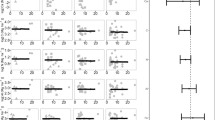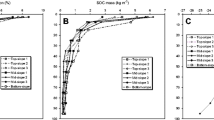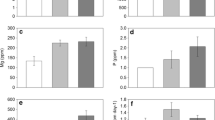Abstract
Ecosystem property and function can be considerably altered by changes in agricultural land use. Despite the expansion of abandoned fields in temperate humid areas worldwide, little is known about how ecosystem C stock and its partitioning change with secondary succession, especially under the invasion of non-native, fast-growing plants. Using a paired-plot approach, we investigated how plant community type (native vs. non-native, the latter represented by Solidago altissima) influences temporal changes in ecosystem C pools in abandoned paddy fields. Thirty-seven plots of control (paddy) and abandoned (2–37 years of succession) pair having similar soil types under the humid temperate climate of Japan were selected for this study. We detected a net loss of ecosystem C in the first 15.2 years, followed by a gradual C gain. Apparent maximal C gain (up to 10 Mg C ha−1) was observed approximately 30 years after abandonment, based on a smooth spline model. The initial C loss was largely attributed to decomposition in mineral-associated soil C, owing presumably to the rapid decay of the C accumulated under temporally anaerobic paddy. While no detectable difference was found in the ecosystem C stock between plots dominated by S. altissima and native plants, the S. altissima-dominated plots showed significantly lower litter C stock. We therefore conclude that, despite the rapid growth and high aboveground biomass of S. altissima, its invasion did not increase ecosystem C storage in the studied region; these findings highlight the absence of ecological benefits associated with S. altissima invasion.





Similar content being viewed by others
References
Arneth A, Sitch S, Pongratz J, Stocker BD, Cias P, Poulter B, Bayer AD, Bondeau A, Calle L, Chini LP, Gasser T, Fader M, Friedlingstein P, Kato E, Li W, Lindeskog M, Nabel JEMS, Pugh TAM, Robertson E, Viovy N, Yue C, Zaehle S. 2017. Historical carbon dioxide emissions caused by land-use changes are possibly larger than assumed. Nature Geoscience 10:79.
Barré P, Angers DA, Basile-Doelsch I, Bispo A, Cécillon L, Chenu C, Chevallier T, Derrien D, Eglin TK, Pellerin S, 2017. Ideas and perspectives: can we use the soil carbon saturation deficit to quantitatively assess the soil carbon storage potential, or should we explore other strategies? Biogeoscience Discussions 1–12.
Buol SW, Southhard RJ, Graham RC, McDaniel PA. 2011. Soil genesis and classification. 6th edn. Ames: Iowa State Univ. Press.
Brye KR, Kucharik CJ. 2003. Carbon and nitrogen sequestration in two prairie topochronosequences on contrasting soils in southern Wisconsin. The American Midland Naturalist 149:90–103.
Cardinael R, Chevallier T, Cambou A, Béral C, Barthès BG, Dupraz C, Durand C, Kouakoua E, Chenu C. 2017. Increased soil organic carbon stocks under agroforestry: a survey of six different sites in France. Agriculture, Ecosystems & Environment 236:243–55.
Cramer VA, Hobbs RJ, Standish RJ. 2008. What’s new about old fields? Land abandonment and ecosystem assembly. Trends in Ecology and Evolution 23:104–12.
Carson WP, Root RB. 2000. Herbivory and plant species coexistence: community regulation by an out breaking phytophagous insect. Ecological Monographs 70:73–99.
Chen A, Xie X, Ge T, Hou H, Wang W, Wei W, Kuzyakov Y. 2017. Rapid decrease of soil carbon after abandonment of subtropical paddy fields. Plant and Soil 415:203–14.
Crow S, Reeves M, Schubert OS, Sierra CA. 2015. Optimization of method to quantify soil organic matter dynamics and carbon sequestration potential in volcanic ash soils. Biogeochemistry 123:27–47.
Deng L, Liu GB, Shangguan ZP. 2014. Land-use conversion and changing soil carbon stocks in China’s ‘Grain-for-Green’ Program: a synthesis. Global Change Biology 20:3544–56.
Dormaar JF, Smoliak S. 1985. Recovery of vegetative cover and soil organic matter during revegetation of abandoned farmland in a semiarid climate. Journal of Range Management 38:487–91.
Ellert BH, Bettany JR. 1995. Calculation of organic matter and nutrients stored in soils under contrasting management regimes. Canadian Journal of Soil Science 75:529–38.
Facelli JM, Pickett STA. 1991. Plant litter: its dynamics and effects on plant community structure. Botanical Review 57:1–31.
Foster BL, Gross KL. 1998. Species richness in a successional grassland: effects of nitrogen enrichment and plant litter. Ecology 79:2593–602.
Google Corporation, 2013. Google Earth Release 7.1.2. Retrieved 7 Oct 2013 from http://earth.google.com/earth/.
Hirose T. 2012. Leaf-level nitrogen use efficiency: definition and importance. Oecologia 169:591–7.
Houghton RA, Nassikas AA. 2017. Global and regional fluxes of carbon from land use and land cover change 1850–2015. Global Biogeochemical Cycles 31:456–72.
IPCC. 2014. Climate change 2014: synthesis report Contribution of Working Groups I, II and III to the Fifth Assessment Report of the Intergovernmental Panel on Climate Change ed R K Pachauri and L A Meyer (Geneva: IPCC).
Japanese Meteorological Agency. 2019. Automated Meteorological Data Acquisition System (AMeDAS). https://www.jma.go.jp/en/amedas, access in July 9, 2019.
Kaiser K, Guggenberger G. 2003. Mineral surfaces and soil organic matter. European Journal of Soil Science 54:219–36.
Kämpf I, Hölzel N, Störrle M, Broll G, Kiehl K. 2016a. Potential of temperate agricultural soils for carbon sequestration: A meta-analysis of land-use effects. Science of The Total Environment. 566:428–35.
Knops JMH, Tilman D. 2000. Dynamics of soil nitrogen and carbon accumulation for 61 years after agricultural abandonment. Ecology 81:88–98.
Kögel-Knabner I, Amelung W, Cao Z, Fiedler S, Frenzel P, Jahn R, Kalbitz K, Kölbl A, Schloter M. 2010. Biogeochemistry of paddy soils. Geoderma 157:1–14.
Kämpf I, Hoelzel N, Stoerrle M, Broll G, Kiehl K. 2016b. Potential of temperate agricultural soils for carbon sequestration: A meta-analysis of land-use effects. Sci. Total Environ. 566:428–35.
Krause A, Pugh TA, Bayer AD, Lindeskog M, Arneth A. 2016. Impacts of land-use history on the recovery of ecosystems after agricultural abandonment. Earth System Dynamics 7:745–66.
Kuhman TR, Pearson SM, Turner MG. 2011. Agricultural land-use history increases non-native plant invasion in a southern Appalachian forest a century after abandonment. Canadian Journal of Forest Research 41:920–9.
Kurganova IN, Kudeyarov VN, Gerenyu LD. 2010. Updated estimate of carbon balance on Russian territory. Tellus B 62:497–505.
Lim SS, Baah-Acheamfour M, Choi WJ, Arshad MA, Fatemi F, Banerjee S, Carlyle CN, Bork EW, Park HJ, Chang SX. 2018. Soil organic carbon stocks in three Canadian agroforestry systems: From surface organic to deeper mineral soils. Forest Ecology and Management 417:103–9.
Long ZT, Mohler CL, Carson WP. 2003. Extending the resource concentration hypothesis to plant communities: effects of litter and herbivores. Ecology 84:652–65.
Pampolino MF, Laureles EV, Gines HC, Buresh RJ. 2008. Soil carbon and nitrogen changes in long-term continuous lowland rice cropping. Soil Science Society of America Journal 72:798–807.
Peixoto KS, Marimon-Junior BH, Marimon BS, Elias F, de Farias J, Freitag R, Mews HA, das Neves EC, Prestes NC, Malhi Y. 2017. Unravelling ecosystem functions at the Amazonia-Cerrado transition: II. Carbon stocks and CO2 soil flux in cerradao forest undergoing ecological succession. Acta Oecologica 82:23–31.
Poeplau C, Don A. 2013. Sensitivity of soil organic carbon stocks and fractions to different land-use changes across Europe. Geoderma 192:189–201.
Quétier F, Lavorel S, Thuiller W, Davies I. 2007. Plant-trait-based modeling assessment of ecosystem-service sensitivity to land-use change. Ecological Applications 17:2377–86.
Raich JW, Tufekciogul A. 2000. Vegetation and soil respiration: correlations and controls. Biogeochemistry 48:71–90.
Rasse DP, Rumpel C, Digna MF. 2005. Is soil carbon mostly root carbon? Mechanisms for a specific stabilisation. Plant and Soil 269:341–56.
Seino H. 1993. An estimation of distribution of meteorological elements using GIS and AMeDAS data. Journal of Agricultural Meteorology 48:379–83.
Six J, Conant RT, Paul EA, Paustian K. 2002. Stabilization mechanisms of soil organic matter: implications for C-saturation of soils. Plant and Soil 241:155–76.
Shimoda S. 2017. Plant-derived carbon and nitrogen addition due to mowing in the early stages of post-agricultural succession. Ecological Engineering 98:24–31.
Shirato Y. 2005. Testing the suitability of the DNDC model for simulating long-term soil organic carbon dynamics in Japanese paddy soils. Soil Science & Plant Nutrition. 51:183–92.
Stoll P, Egli P, Schmid B. 1998. Plant foraging and rhizome growth patterns of Solidago altissima in response to mowing and fertilizer application. Journal of Ecology 86:341–54.
Swanston CW, Torn MS, Hanson PJ, Southon JR, Garten CT, Hanlon EM, Ganio L. 2005. Initial characterization of processes of soil carbon stabilization using forest stand-level radiocarbon enrichment. Geoderma 128:52–62.
Takahashi M, Ishizuka S, Ugawa S, Sakai Y, Sakai H, Ono K, Hashimoto S, Matsuura Y, Morisada K. 2010. Carbon stock in litter, deadwood and soil in Japan’s forest sector and its comparison with carbon stock in agricultural soils. Soil Science & Plant Nutrition 56:19–30.
Uriarte M. 2000. Interactions between goldenrod (Solidago altissima L.) and its insect herbivore (Trirhabda virgata) over the course of succession. Oecologia 122:521–8.
von Lützow M, Kögel-Knabner I, Ekschmitt K, Flessa H, Guggenberger G, Matzner E, Marschner B. 2007. SOM fractionation methods: relevance to functional pools and to stabilization mechanisms. Soil Biology and Biochemistry 39:2183–207.
van der Zanden EH, Verburg PH, Schulp CJE, Verkerk PJ. 2017. Trade-offs of European agricultural abandonment. Land Use Policy 62:290–301.
Vesterdal L, Ritter E, Gundersen P. 2002. Change in soil organic carbon following afforestation of former arable land. Forest Ecology and Management 169:137–47.
Wagai R, Mayer LM, Kitayama K. 2009. Nature of the “occluded” low-density fraction in soil organic matter studies: A critical review. Soil Science and Plant Nutrition 55:13–25.
Wagai R, Kajiura M, Uchida M, Asano M. 2018. Distinctive roles of two aggregate binding agents in allophanic Andisols: young carbon and poorly-crystalline metal phases with old carbon. Soil Systems 2:29 (p23).
Washitani I. 2001. Plant conservation ecology for management and restoration of riparian habitats of lowland Japan. Population Ecology 43:189–95.
Weber E. 2001. Current and potential ranges of three exotic goldenrods (Solidago) in Europe. Conservation Biology 15:122–8.
Wiesmeier M, Hübner R, Spörlein P, Geuß U, Hangen E, Reischl A, Schilling B, von Lützow M, Kögel-Knabner I. 2014. Carbon sequestration potential of soils in southeast Germany derived from stable soil organic carbon saturation. Global Change Biology 20:653–65.
Yagasaki Y, Shirato Y. 2014. Assessment on the rates and potentials of soil organic carbon sequestration in agricultural lands in Japan using a process-based model and spatially explicit land-use change inventories–Part 1: Historical trend and validation based on nation-wide soil monitoring. Biogeosciences 11:4429–42.
Yang X, Ren W, Sun B, Zhang S. 2012. Effects of contrasting soil management regimes on total and labile soil organic carbon fractions in a loess soil in China. Geoderma 177:49–56.
Zhang K, Dang H, Tan S, Cheng X, Zhang Q. 2010. Change in soil organic carbon following the ‘Grain-for-Green’ programme in China. Land Degradation & Development 21:13–23.
Zhang K, Cheng X, Dang H, Ye C, Zhang Q. 2013. Linking litter production, quality and decomposition to vegetation succession following agricultural abandonment. Soil Biology and Biochemistry 57:803–13.
Zhang L, Zhan Y, Jianwen Z, Evan S. 2014. Decomposition of Phragmites australis litter retarded by invasive Solidago canadensis in mixtures: an antagonistic non-additive effect. Scientific Reports 4:5488. https://doi.org/10.1038/srep05488.
Acknowledgements
This study was financially supported by the Ministry of Agriculture, Forestry, and Fisheries, Japan, through a research project entitled ‘Development of technologies for mitigation and adaptation to climate change in Agriculture, Forestry and Fisheries.’ We thank Dr Kazuyuki Yagi (King Mongkut’s University of Technology Thonburi) for the support in planning the study and Mutsuko Iwahara, Yoshinobu Fujimoto, and Tomoko Ogawa (NARO Western Region Agricultural Research Center), and Mieko Takasugi and Tomoko Emura (NARO Hokkaido Agricultural Research Center) for their assistance with plant and soil sample analysis.
Author information
Authors and Affiliations
Corresponding author
Additional information
Authors’ Contribution
SS contributed to conception and design, and acquisition of data; SS and RW took part in analysis and interpretation of data; SS drafted the article; RW revised the article critically for important intellectual content. Both authors contributed to edit the manuscript and gave the final approval for publication.
Electronic Supplementary Material
Below is the link to the electronic supplementary material.
Rights and permissions
About this article
Cite this article
Shimoda, S., Wagai, R. Ecosystem Dynamics After Abandonment of Rice Paddy Fields: Does Alien Plant Invasion Enhance Carbon Storage?. Ecosystems 23, 617–629 (2020). https://doi.org/10.1007/s10021-019-00426-1
Received:
Accepted:
Published:
Issue Date:
DOI: https://doi.org/10.1007/s10021-019-00426-1




